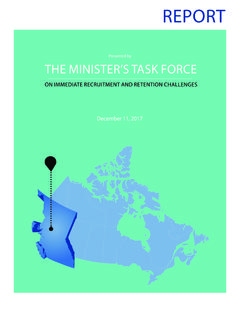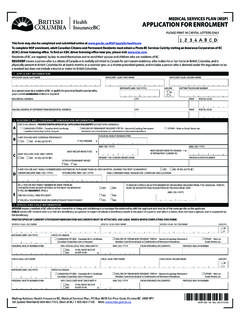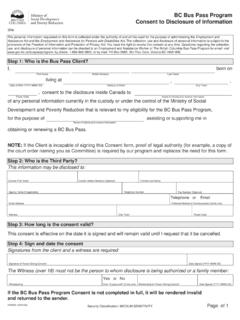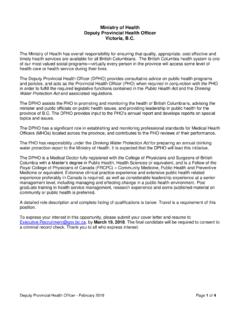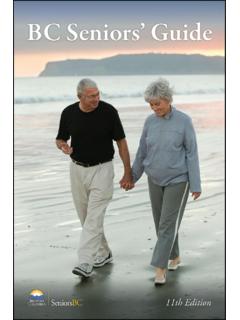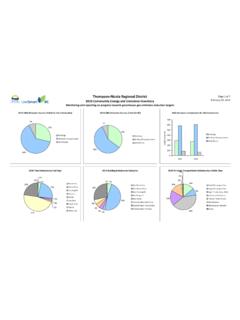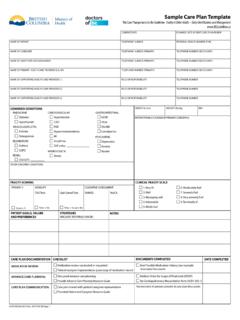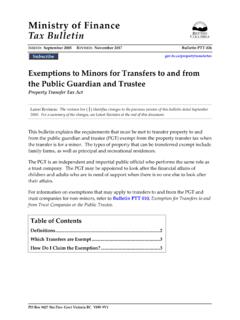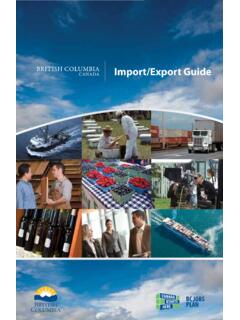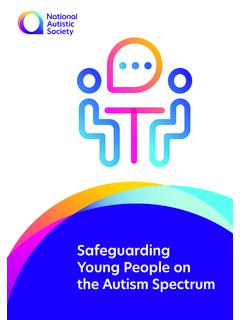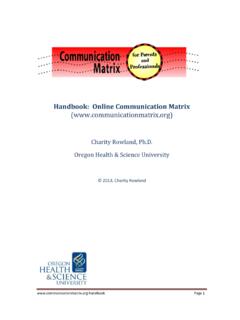Transcription of Provincial COVID-19 Communicable Disease Guidelines for K ...
1 Summary of Key Updates Updated guidance regarding mask requirements in the following sections: Working with Students with disabilities /Diverse Abilities ( ) Student Transportation ( ) Personal Protective Equipment ( ) Music Programs ( ) Physical and Health Education/Outdoor Programs ( ) School Sports ( ) Theatre, Film & Dance Programs ( ) Provincial COVID-19 Communicable Disease Guidelines for K-12 Settings Updated October 1, 2021 2 Contents INTRODUCTION .. 4 4 KEY PRINCIPLES .. 4 Communicable Disease PLANS .. 5 REGIONAL DIFFERENCES .. 5 INFECTION PREVENTION & EXPOSURE CONTROL MEASURES.
2 6 SUPPORTIVE SCHOOL ENVIRONMENTS .. 7 VACCINES .. 8 PHYSICAL DISTANCING AND SPACE ARRANGEMENT .. 8 STAFF ONLY SPACES .. 9 SCHOOL GATHERINGS AND EVENTS .. 9 PERSONAL ITEMS .. 10 SUPPORTING STUDENTS with disabilities /DIVERSE ABILITIES .. 10 EXPECTATIONS FOR SCHOOL DISTRICTS AND SCHOOLS .. 10 Guidelines FOR STAFF WORKING with STUDENTS with disabilities /DIVERSE ABILITIES WHERE PHYSICAL CONTACT MAY BE REQUIRED .. 10 STUDENT TRANSPORTATION .. 11 BUSES .. 11 CARPOOLING .. 11 OTHER METHODS OF TRANSPORTATION .. 12 CLEANING AND DISINFECTING .. 12 DEFINITIONS .. 12 PRODUCTS & PROCEDURES .. 12 CLEANING AND DISINFECTING FREQUENCY.
3 13 FREQUENTLY TOUCHED SURFACES .. 13 CLEANING AND DISINFECTING BODILY FLUIDS .. 14 14 Provincial COVID-19 Communicable Disease Guidelines for K-12 Settings Updated October 1, 2021 3 VISITOR ACCESS/COMMUNITY USE .. 14 STUDENT ATTENDANCE .. 15 ILLNESS & SELF-ASSESSMENT POLICIES AND PROTOCOLS .. 15 DAILY HEALTH CHECK .. 15 SCHOOL AND SCHOOL DISTRICT RESPONSIBILITIES .. 16 STAYING HOME, SELF-ISOLATION AND SYMPTOMS .. 16 Stay Home When Required to Self-Isolate .. 16 Symptoms of Illness and Return to School .. 17 PROTOCOLS FOR MANAGING ILLNESS AND EXPOSURES AT SCHOOL .. 17 HAND HYGIENE .. 17 RESPIRATORY ETIQUETTE .. 18 PERSONAL PROTECTIVE EQUIPMENT (PPE).
4 19 GENERAL VENTILATION AND AIR CIRCULATION .. 21 EMERGENCY AND EVACUATION DRILLS .. 22 COMMUNICATION AND TRAINING/ORIENTATION .. 22 CURRICULUM, PROGRAMS AND ACTIVITIES .. 23 DUAL CREDIT .. 24 FIELD TRIPS .. 24 FOOD / CULINARY PROGRAMS .. 24 FOOD SERVICES .. 25 FUNDRAISERS .. 25 KINDERGARTEN PROGRAM AND ENTRY .. 25 MUSIC PROGRAMS .. 26 SHARED OFFICE SPACE FOR STAFF .. 26 PHYSICAL AND HEALTH EDUCATION (PHE)/OUTDOOR PROGRAMS .. 26 PLAYGROUNDS .. 27 SCHOOL LIBRARIES / LEARNING COMMONS .. 27 SCHOOL SPORTS .. 28 TRADES IN TRAINING PROGRAMS .. 28 THEATRE, FILM, AND DANCE PROGRAMS .. 29 WORK EXPERIENCE .. 29 EXTRACURRICULAR ACTIVITIES.
5 30 APPENDIX A: COVID-19 SYMPTOMS, TESTING & RETURN TO SCHOOL .. 31 APPENDIX B: Communicable Disease PLAN ORIENTATION CHECKLIST .. 32 4 Introduction School supports students in developing their potential and acquiring the knowledge, skills and abilities they need for lifelong success. In-person learning, as a part of a studentpeer engagement, which supports social and emotional development as well as overall wellness. It also provides many students access to programs and services that are integral to their overall health and well-being. Based on guidance from the BC Centre for Disease Control and experience to date within and other jurisdictions showing schools as low-risk sites for COVID-19 transmission, even with increased risk of COVID-19 in some communities, K-12 students can participate in full-time, in-class instruction in accordance with current public health Guidelines for schools.
6 To date, the Ministry of Education has allocated over $331 million in Provincial and federal funding for the 2020/21 and 2021/22 school years to support the implementation of enhanced health and safety measures and pandemic recovery efforts in public and independent schools. Schools and school districts have utilized these funds, as well as local reserves, to increase the number of hand-hygiene stations in schools, purchase cleaning supplies and personal protective equipment, improve ventilation, hire custodial staff and support remote learning, among other measures. O B J E C T I V E S This document was developed by the Ministry of Education in collaboration with the BC Centre for Disease Control, Indigenous rightsholders and education partners including teachers, parents and school leaders to outline the principles and requirements for maintaining safe learning environments.
7 These comprehensive Guidelines build on the Public Health Communicable Disease Guidance for K-12 Schools developed by the BC Centre for Disease Control (BCCDC) to ensure schools have effective measures in place to prevent the transmission of COVID-19 . These Guidelines are intended to support K-12 education employees, students, parents, caregivers, administrators and school community members to: Be informed about Communicable Disease measures and how they support a safe school environment; Understand their roles and responsibilities in maintaining and promoting safe and healthy schools. K E Y P R I N C I P L E S All schools are to adhere to the standards, Guidelines and protocols from the BC Centre for Disease Control and WorkSafeBC.
8 The Communicable Disease Guidelines outlined in this document have been developed to complement guidance from the BC Centre for Disease Control (Public Health Communicable Disease Guidance for K-12 Schools) and WorkSafeBC. All boards of education and independent school authorities are required to have Communicable Disease plans in place that adhere to the Guidelines outlined in this document. o In the case of any variance between the Guidelines in this document and the guidance in Public Health Communicable Disease Guidance for K-12 Schools, schools and school districts should follow the Guidelines outlined in this document.
9 5 o Schools and school districts are expected to update their Communicable Disease plans in alignment with updates to the Guidelines outlined in this document, and to post their updated plans on their school/school district website. Schools should implement psychological safety measures and trauma-informed practice alongside physical health and safety measures. See the K-12 Education Recovery Plan for more information. Effective and ongoing communication with school leaders, community partners, Indigenous rightsholders, parents, caregivers, students, unions and employees is an essential aspect of successfully implementing these Guidelines .
10 C O M M U N I C A B L E D I S E A S E P L A NS statement on June 17, 2021, employers are no longer required to maintain a COVID-19 Safety Plan but must instead transition to Communicable Disease prevention1. Communicable Disease prevention focuses on reducing the risk of workplace transmission of COVID-19 and other Communicable diseases, and includes both ongoing measures ( hand hygiene, cleaning) and additional measures to be implemented as advised by public health. Communicable Disease prevention: A guide for employers outlines a four-step process to reduce the risk of Communicable Disease transmission in the workplace.

